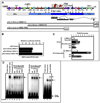Cloning and characterization of the 5'UTR of the rat anti-apoptotic Bcl-w gene
- PMID: 19766102
- PMCID: PMC2764318
- DOI: 10.1016/j.bbrc.2009.09.049
Cloning and characterization of the 5'UTR of the rat anti-apoptotic Bcl-w gene
Abstract
The anti-apoptotic Bcl-w regulator, which is expressed in the developing and mature brain, not only promotes neuronal survival, but also neuronal differentiation. However, its transcriptional regulation remains to be elucidated due to a lack of knowledge of the Bcl-w promoter. Here, we report the mapping and characterization of the rat Bcl-w promoter, which is highly conserved between the human, mouse, and rat species. Using a series of 5' and 3' deletions, we mapped the TATA-less minimal Bcl-w promoter and showed that it is under a combinatorial regulation with the neurogenic bHLH transcription factor NeuroD6 mediating its activation, validating our previous finding of increased expression of the Bcl-w protein in stably transfected PC12-NeuroD6 cells. Upon stress, NeuroD6 promotes colocalization of Bcl-w with mitochondria and endoplasmic reticulum. Finally, we provide the first evidence of Bcl-w localization in the growth cones of differentiating neuronal cells, suggestive of a potential synaptic neuroprotective role.
Figures





References
-
- Oppenheim RW. Cell death during development of the nervous system. Annu. Rev. 1991;14:453–501. - PubMed
-
- Putcha GV, Johnson EM., Jr Men are but worms: neuronal cell death in C. elegans and vertebrates. Cell Death Differ. 2004;11:38–48. - PubMed
-
- Benn SC, Woolf CJ. Adult neuron survival strategies- slamming on the brakes. Nature Rev. Neurosci. 2004;5:686–700. - PubMed
-
- Schwab MH, Bartholomae A, Heimrich B, Feldmeyer D, Druffel-Augustin S, Goebbels S, Naya FJ, Zhao S, Frotscher M, Tsai MJ, Nave KA. Neuronal basic helix-loop-helix proteins (NEX and BETA2/Neuro D) regulate terminal granule cell differentiation in the hippocampus. J Neurosci. 2000;20:3714–3724. - PMC - PubMed
Publication types
MeSH terms
Substances
Grants and funding
LinkOut - more resources
Full Text Sources
Research Materials

